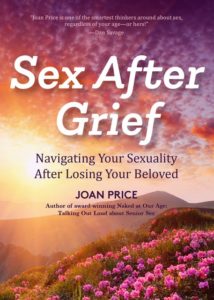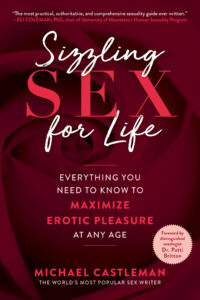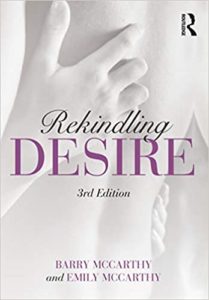Posts by Joan Price
How Can I Reach Orgasm More Easily?
“It’s hard for me to reach orgasm,” women over 60 often write me. “What can I do?” Although your stories are unique, the essential question is often the same: “How can I reach orgasm more easily?”
Consult your doctor for a medical cause.
- “I have a few illnesses and I’m on medications.”
- “I’ve always been able to orgasm easily but for the past year and a half, I’ve been losing almost all sensation. I have not talked with my doctor about this.”
Many of you mention your medical conditions when you ask me for advice. You need to have this conversation with your doctor who knows your condition or your pharmacist who knows the sexual side effects of your medications. If your medical professional is dismissive of you or embarrassed that you’re asking about sex, you need a new one who is sex-positive and age-positive. This is essential for your quality of life! See “Talk to Your Doctor about Sex” for help starting this conversation.
Expand your sexual repertoire.
- “I have been unable to have orgasms because my husband is impotent.”
About 75 to 80 percent of women do not reach orgasm through intercourse, and I suspect that percentage is higher in our age group. We need clitoral stimulation before, during, or instead of intercourse. Your husband’s erectile dysfunction does not need to be an impediment to satisfying sex for both of you — there are many other ways to give and receive sexual pleasure. Watch my webinar, “Great Sex without Penetration.”

Great Sex Without Penetration webinar banner
Use sex toys for faster arousal and orgasm.
- “I would like to know how to reach an orgasm on my own, as my husband is not interested. I have a vibrator and sometimes it helps, but most often it doesn’t.”
- “I have started to buy some sex toys for solo play, but I just cannot get an orgasm.”
- “I prefer to use a device of some kind. But I don’t know what to look for.”
Read my advice above about consulting your doctor in case there’s a medical cause for your inability to reach orgasm. If not, it’s likely that you haven’t found the right vibrator to make orgasms happen for you. There are many different types, and each has a variety of shapes, sizes, and intensities. The vibrations can range from buzzy to rumbly and from mild to turbo-powered.
Start with my blog post, “How to Choose a Vibrator.” Then, armed with your knowledge of what you’re looking for, read my reviews of specific vibrators, all from a senior perspective. (There are many reviews, so keep selecting “older posts” at the bottom of the page.) A faster way to see and learn about a selection of my favorites is to view my webinar, “Sex Toys for Seniors.”

If you’re partnered, communicate what feels good and what doesn’t.
- “My husband is never very good at sex and consequently I suffer. I’m trying to find a way to achieve satisfaction.”
Does your husband refuse or “forget” to do what pleases you? Or does he not know, because you haven’t found a way to communicate what you need? We grew up during an era of embarrassment about sex, and for many of us, it’s still difficult to talk to a partner about our sexual needs. Work on asking for what feels good to you. My book, The Ultimate Guide to Sex after 50, has an entire chapter on improving sex with a longtime partner, including how to find the right words for communicating your needs.
If you’re solo, enjoy self-pleasuring often.
- “My husband died 4 years ago. I haven’t had any sexual activity in about 10 years. I think I just want solo sex. Could you help me
 please?”
please?”
I’m so sorry for your loss. Grief often numbs our natural need for sex, though for some, it has the opposite effect. (Learn more from Sex After Grief: Navigating Your Sexuality After Losing Your Beloved.)
Be patient if you’re just getting back to sexual activity after a decade. Your body and brain became accustomed to doing without sex, and your drive and responsiveness receded. Some tips to improve this:
- Enjoy solo sex during the time of day you feel energetic and excitable. I call that your “tingle time.”
- Exercise first to increase blood flow to the genitals for faster arousal.
- Eat after sex, not before, so that the blood flow is not diverted to the digestive system.
“A Senior’s Guide to Solo Sex,” one of my most popular articles for Senior Planet (with 137 comments!), has more suggestions. The more you do it, the easier it becomes.
Your take-away tips:
- Consult your doctor for a medical cause.
- Expand your sexual repertoire.
- Use sex toys for faster arousal and orgasm.
- If partnered, communicate what feels good and what doesn’t.
- If solo, enjoy self-pleasuring often.
- The more sexually active you are — partnered or solo — the easier it becomes to reach orgasms.
(This article first appeared in a somewhat different form at Senior Planet as “Ask Joan: Easier Orgasms” on July 20, 2020.)
Sizzling Sex for Life by Michael Castleman
Sizzling Sex for Life by Michael Castleman
reviewed by Mac Marshall
Are you a man who wishes that sex was more pleasurable? Do you feel furtive about masturbating? Do you have erectile problems? Do you feel guilty watching porn? Do you believe that your penis is too small? Do you desire sex more than your spouse/partner does? Sizzling Sex for Life: Everything You Need to Know to Maximize Erotic Pleasure at Any Age by Michael Castleman offers sex-positive answers to questions like these and many others, based upon the best available current knowledge.
This book largely addresses the sexual issues facing cisgendered heterosexuals—nine out of ten people…While I write for men, I’ve also striven to be sensitive to women, to inform men of the many research breakthroughs of the past few decades…that have shined new light on how women experience erotic pleasure…[I have] also endeavored to inform women about men’s experience of sexuality.
Castleman’s book is a 432-page encyclopedic compendium covering a host of different sex topics. His 52 chapters are organized into six major parts:
I. The Ten Ingredients of Sizzling Sex. (10 chapters; 66 pages)
II. From Infancy to Old Age: Sexual Issues Throughout the Lifespan. (20 chapters; 155 pages)
III. A Guide to Resolving Men’s Sex Problems. (4 chapters; 38 pages)
IV. The Man’s Guide to Women’s Sexuality. (5 chapters; 35 pages)
V. Other Ways to Play. (6 chapters; 43 pages)
VI. What Everyone Should Know About Pornography. (7 chapters; 54 pages)
Castleman’s recipe for “sizzling sex” is summarized in Part I. In a mantra repeated over and again throughout the book he argues, “For sizzling sex, your default position should always be slow, tender, mutual massage that eventually—after twenty minutes or so—extends to gentle, playful genital caresses.”
Other recommended ingredients for sizzling sex include:
- Coaching your partner. “Everyone is sexually unique…No one can read anyone’s erotic mind. No one can possibly know what you like and dislike unless you reveal it. For sizzling sex you must speak up.”

- Obtaining affirmative consent. “Women have become fed up with the problems inherent in no means no and have promoted a new standard, yes means yes—clear, unambiguous consent for every sexual escalation—‘affirmative consent’.”
- Using lubricants. “Currently, an estimated fifty million Americans use lubricant regularly. Most consider it a quick, easy, inexpensive, erotic enhancement.”
- Introducing novelty. “To make sex hotter, include something new: a different time or place, new moves, new lingerie, a new sex toy—anything.”
- Indulging sexual fantasies. “An active erotic imagination contributes to sizzling sex by boosting libido, aiding arousal, and enhancing pleasure.”
- Masturbating. “Masturbation is the foundation of satisfying sex and the world’s most widely practiced type of lovemaking…If you feel ambivalent about making
love with yourself, it’s difficult to have great sex with anyone else.” - Engaging in outercourse, including oral sex. “Many people rank oral sex, fellatio, and cunnilingus, among their top erotic pleasures…Gentlemen, if you want your partner to feel sexually satisfied and sing your praises, what hangs between your legs is usually less important than how creatively you use your tongue.”
- Focusing on pleasure. “All genders’ top three reasons [for engaging in sex] focus on attraction and pleasure…Having children was one of the fifty least cited reasons for partner lovemaking…The goal of sex is not orgasm but mutual pleasure.”
- Scheduling lovemaking. “In established relationships, sex therapists are virtually unanimous in the opinion that scheduled sex offers couples the best chance for long-term erotic happiness.”
Many chapters stand alone for those who seek answers to certain questions. For example, Chapter 12 offers “A Parents’ Guide to Toddlers’ and Preschoolers’ Natural Sexual Curiosity,” and Chapter 20 provides suggestions on “How to Prevent Sexual Assault and Harassment.” Chapter 36 discusses “A Man’s Guide to Women’s Bodies.” This makes the book particularly useful to sex counselors and therapists who may direct clients to specific chapters relating to their clinical discussions.
Overall, the book is splendid, but I had a few issues:
- It’s problematic that Castleman’s discussion of sex toys leaves the impression that they’re all for women or for men to use on women. He fails to mention the numerous penis toys that have come on the market over the past decade that enhance sexual pleasure for men (e.g., the Pulse and Jett from Hot Octopuss, the Manta from Fun Factory, and the Ion from Arcwave). Moreover, I can personally attest that many vibrators designed for vulvas provide wonderful stimulation to penises as well.
- This important book harbors a certain amount of repetitiveness that might have been eliminated with more careful editing. While some of this may be intended to hammer home certain key points, much of it uses the same wording over and over. Some examples: we’re told many times that porn is like a cartoon version of sex; that 5%-6% of normal, mentally healthy women are highly sexual; that all men watch and masturbate to porn; that Fifty Shades of Grey sold 150 million copies worldwide in fifty languages during its first eight years in print; that men tend to become more sexually aroused than women by visual imagery; and that only 25 percent of women are consistently orgasmic from vaginal intercourse alone.
- As it stands, the book ends very abruptly following a 54-page discussion of porn. I would have appreciated a brief chapter that summarized and highlighted the author’s main points and brought the reader full circle.
A strength of Sizzling Sex for Life is the author’s lively and accessible writing style. He presents sometimes complex information in an easily comprehensible manner, often laced with humor. For example, “Fellatio is as simple as eating a banana—without using your teeth.”
He also provides historical tidbits:
The ancient Greeks and Romans preferred small penises. In Aristophanes’s play The Clouds (423 BC), an elder admonishes delinquent boys that if they continue to misbehave, as punishment, their penises will grow larger. But if they repudiate wickedness, their organs will remain blessedly small. What the Greeks wanted was a jumbo scrotum. A big nut sack suggested great potency. The Greeks considered penises incidental injection devices for what really counted, big ejaculations. Five centuries later, the Roman novel Satyricon (ca. AD 50) describes bathers at a public bath who ridicule one character’s large penis.
Throughout much of the book, Castleman notes the special sexual issues associated with aging for men and women alike. This is welcome information for senior readers age 50 and beyond. He gives special attention to erectile problems for men, vaginal dryness for women, and the delightful joys of slow, gentle outercourse as pleasurable sex for seniors. He also devotes all of Chapter 29 (“No One is Ever Too Old for Sizzling Sex”) to older folks, commenting that “Elder sex just might be the best of your life.” We agree!

Michael Castleman is a journalist who specializes in health and sexuality. Over the course of his long career, he has worked as a counselor at a family planning clinic, was employed by a company that marketed sex toys, wrote answers for the Playboy Advisor column in Playboy Magazine, and authored two earlier sex books. He currently writes the “All About Sex” blog for Psychology Today and answers sex questions from readers at GreatSexGuidance, In assembling the wide-ranging materials for Sizzling Sex for Life, he has drawn on this varied background and his extensive personal network of sex counselors, coaches, and therapists.

Purchase Sizzling Sex for Life from https://sizzlingsexforlife.com/.
================

Mac Marshall, PhD is a retired anthropology professor, researcher, and author who is delighted to explore sexuality studies at this time of his life.
Vaginal and Vulvar Pain
- My vaginal opening feels very tight and when I insert a finger it is uncomfortable to the point of being painful. Is this lack of use or just vaginal dryness? For some reason, I am suddenly always horny and would like to be active with my husband.
- I have severe vaginal atrophy and dryness. I use Replens and a topical lubricant, but they barely help. Because of multiple family members with breast cancer, two gynecologists said, “Absolutely not!” to hormone replacement. Even if I touch myself indirectly, it hurts incredibly. It’s like my vagina is raw.
- I am unable to have sex with my husband due to my pain. When he tries, it feels like I’m tightening the muscles without realizing it or meaning to I’m suffering and so is my husband because we can’t have sex anymore.
- I can get aroused and I want to be sexually satisfied—I’m itching, squirming and don’t get a second’s sleep all night long. Sometimes I try to please myself gently, but touching is too painful, and I can’t reach orgasm. If I keep trying, I’m in pain for three or four days.
I keep getting questions such as these about vaginal and vulvar pain. It’s a big problem. Rather, it’s many big problems, because genital pain can be caused by a variety of medical conditions. You can tell that the examples above all have pain in common, but the type of pain, location, and what provokes it vary.
It’s essential to determine what condition is causing your pain, because each condition requires its own treatment. If you only know that it hurts, but you don’t know what is causing your pain, you can’t know how to treat it. That’s why your course of action should include these:
- Pin down your symptoms exactly, and learn as much as you can about what might be causing your pain. An
 excellent new book to help you do this is The Vagina Bible: The Vulva and the Vagina—separating the Myth from the Medicine by gynecologist Jennifer Gunter. The second half of this book is a comprehensive resource about infections, conditions, symptoms, and treatments for sexual pain.
excellent new book to help you do this is The Vagina Bible: The Vulva and the Vagina—separating the Myth from the Medicine by gynecologist Jennifer Gunter. The second half of this book is a comprehensive resource about infections, conditions, symptoms, and treatments for sexual pain.
- Find the right medical professional to help you. If your gynecologist doesn’t take the time or have the skills to figure out why you’re in pain, ask for a referral. Don’t let your doctor dismiss you with “Why do you care about sex at your age?” or a similar attitude. If you hear that, divorce your doctor and find a new one who is sex-positive and age-positive.
- A pelvic floor therapist is trained to diagnose and treat sexual pain and might be the best professional for you. Find a provider here.
What can you do about sex meanwhile? If you’re partnered, be honest with your mate about what you’re feeling. Expand your sexual expression to include activities that arouse you and your partner without hurting you. If vaginal penetration hurts, but the vulva welcomes touch, explore ways to arouse yourself that bring you pleasure without pain. If all genital touching is painful, are there other erogenous zones on your body that invite erotic caressing? Are there ways you can pleasure your partner that you’re happy to do? Please view my “Great Sex Without Penetration” webinar: 90 minutes filled with helpful information and suggestions.
More about The Vagina Bible, which I recommend wholeheartedly: Dr. Gunter offers individual chapters on five sexually transmitted infections, seven vaginal/vulvar conditions, and six sets of symptoms. She explains clearly what each condition is, how it is diagnosed, and treatment options.
For example, tightness of the vaginal opening might be pelvic floor muscle spasm (PFMS), where the muscles that wrap around the vagina spasm and cannot relax, making penetration excruciating or impossible. This may feel like the vagina has shrunk and is too narrow, or it may feel like a roadblock is preventing penetration. Vaginismus is a type of PFMS where the muscles spasm only before sexual penetration, not all the time.
Most women have never heard of PFMS and most of the other conditions that can cause vaginal or vulvar pain, which is a statement about our society’s hush-hush attitude toward women’s sexual symptoms. We all know about erectile dysfunction, right? But how many vaginal conditions can you name? In Dr. Gunter’s words:
Pain with vaginal intercourse affects up to 30 percent of women. While for many women this is temporary, it can be very distressing. What is also upsetting is many women do not get a diagnosis, never mind therapy. Some women are led to believe that pain with sex is normal or that it is somehow their fault. Pain with sex is a medical condition.
Bottom line: If you have pain, read the relevant chapters of “The Vagina Bible,” then, armed with this information, consult your doctor.
Some additional resources:
- Painful Sex: Where to Go for Help. More resources and an overview of some reasons for vulvar/vaginal pain.
- Vaginal Renewal™ program from A Woman’s Touch Sexuality Resource Center: Self-help program for maintaining a healthy vulva and vagina after menopause.
- A Senior’s Guide to Lubrication: A good lubricant is essential for comfort, whether you experience pain or just the normal dryness of aging.

===
This article was originally published in a slightly different form in October 2019 as “Ask Joan: Intimate Pain” on Senior Planet, where Joan Price answers questions in her monthly column.
Rekindling Desire (3rd Ed.) by Barry and Emily McCarthy
Rekindling Desire (3rd Ed.)
by Barry and Emily McCarthy
Reviewed by Mac Marshall, PhD
“The most disruptive sexual problem is low desire.”
Do you find that you have little desire for sex with your partner? As a couple do you have sex only a few times a year, if at all? Does one of you want more sex than the other, resulting in arguments, recrimination, blame, and hurt feelings? Are you convinced that your “sex light” has gone out? Do you wonder how to bring back intimacy in a marriage? To rekindle desire is to revitalize, reawaken, and reignite it, and that is the focus of Rekindling Desire (3rd Ed.) by Barry and Emily McCarthy. Their motivation for writing this book is to provide “new insights, support, and hope for couples facing desire problems, a no sex or low sex relationship, and desire discrepancy.”
In our youth and young adulthood, most of us experience spontaneous desire, driven by our hormones. Typically as we age, the hormonally triggered desire for sex becomes less pressing. Many people begin to feel less sexy, less desirous, in and beyond their 40s. That doesn’t have to be the end of sex! We can revivify the relationship by understanding “responsive desire.” Learning to give each other sensual pleasure, including plenty of touching, will stimulate responsive desire for sex in both partners.
Rekindling Desire will be of particular help to those in low-desire relationships, or to couples where there is a discrepancy in desire, with one person pursuing sexual connection while the other distances. It offers thorough explanations of what sex therapists have found to be effective for resolving sexual problems and dysfunction resulting from low desire.
This 247-page book is organized into three parts: Awareness (5 chapters), Change (6 chapters), and Relapse Prevention (4 chapters):
- When and Why Couples Lose Sexual Desire. “Desire problems can occur among all types of couples and all age groups.”
- Whose Problem Is It? Hers, His, or Ours? “Sexual desire and desire problems are best understood as a couple issue.”
- Turnoffs: Poisons for Sexual Desire. “A myriad of psychological, bio-medical, and social/relational factors can poison desire.”
- Finding Your Voice: Celebrating Female Sexuality. “The biggest mistake people make is to define female sexuality narrowly. Sex does not equal intercourse. Sexual satisfaction does not equal orgasm.”
- The New Male Sexuality: Confronting Autonomous Sex Performance. “For the great majority of males…sexual dysfunction causes low desire. The main male sexual dysfunctions are premature ejaculation (PE), erectile dysfunction (ED), and ejaculatory inhibition.”
- Being an Intimate Sexual Team: Discovering Your Couple Sexual Style. “Your couple sexual style has two dimensions: first, how to balance each person’s sexual autonomy (“sexual voice”) with being an intimate sexual team; second, how each couple sexual style integrates intimacy and eroticism.”
- Building Anticipation: Bridges to Sexual Desire. “The prescription for sexual desire is positive anticipation, an emotionally intimate relationship, nondemand pleasuring, erotic scenarios and techniques, sharing orgasm, feeling emotionally bonded and satisfied, and maintaining a regular rhythm of sexual contact.”
- Attachment: Enhancing Intimacy. “The essence of intimacy is feeling emotionally open, securely attached, and personally valued.”
- Nondemand Pleasuring: Let’s Play Touchy-Feely. “Pleasuring includes affectionate, sensual, and playful touch, both inside and outside the bedroom.”
- Challenging Inhibitions and Avoidance: Be Sexually Present. “It is both an individual and couple task to increase awareness and challenge inhibitions.”
- Creating Erotic Scenarios: Vital Sexuality. “The essence of eroticism is scenarios and techniques that increase anticipation, subjective and objective arousal, and erotic flow. This includes, but is not limited to, intercourse.”
- Maintaining Gains: Keeping Sexuality Vital and Satisfying. “The core of relapse prevention is awareness that intimacy and sexuality need continual time and energy.”
- Intimate Attachment: Enhancing Your Bond. “Intimacy dates are a powerful resource for preventing relapse and reinforcing relational satisfaction.”
- The Erotic Marriage: Lusting for Life. “You need to challenge routine and mechanical sex, which is a death knell for desire. Eroticism….must be actively cultivated.”
- Valuing a Satisfying, Secure, and Sexual Relationship. “Commit to maintaining a vital sexual bond. Try to go no longer than 2 weeks without some kind of sexual contact. Sex cannot be taken for granted or treated with benign neglect.”

Each chapter is packed with information and also includes a case study, an exercise, a summary, and key points. This is a book you’ll want to study, not read quickly.
In Barry and Emily McCarthy’s view, rekindling desire relies heavily on a couple’s ability to engage in frank, clear, nonjudgmental communication. They see their book as an adjunct to therapy for those who wish to reawaken intimacy and passion in their relationship. “This is a book of ideas, guidelines, and exercises, not a ‘do it yourself’ therapy book,” they state. “It is not a substitute for sex, couple, or individual therapy.”
Barry McCarthy, PhD is a professor of psychology at American University, a diplomate in clinical psychology, a diplomate in sex therapy, and a certified couple therapist. He is the author of over 100 articles, 33 book chapters and 21 books. He has presented over 450 professional workshops nationally and internationally. He received the SSTAR Masters and Johnson award for lifetime contributions to the sex therapy field.
certified couple therapist. He is the author of over 100 articles, 33 book chapters and 21 books. He has presented over 450 professional workshops nationally and internationally. He received the SSTAR Masters and Johnson award for lifetime contributions to the sex therapy field.
Emily McCarthy received a B.S. degree in speech communication, and her writing and wisdom provides a balanced humanistic perspective. This is Barry and Emily’s 14th co-authored book. They have been married for 52 years.
Purchase Rekindling Desire (3rd Ed.)
================

Mac Marshall, PhD is a retired anthropology professor, researcher, and author who is delighted to explore sexuality studies at this time of his life.

